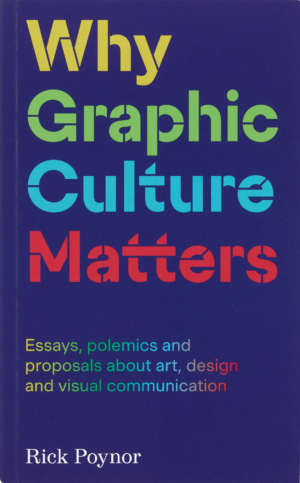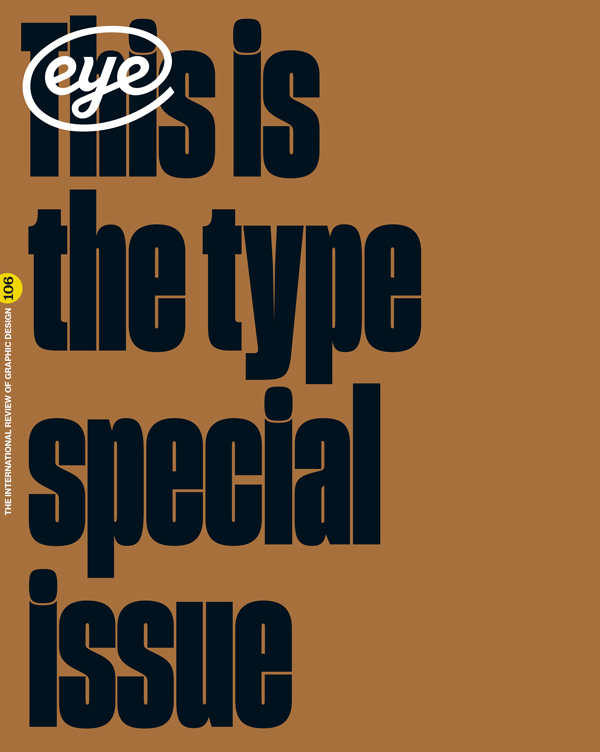Summer 2024
A compilation with clout
Why Graphic Culture Matters
By Rick Poynor. Designed by Sara De Bondt. Occasional Papers, £22. Reviewed by Louise Sandhaus
Rare are those who write about graphic design but are not graphic design practitioners or academics themselves. Even more rare are those with enough to say on the subject to spend more than 40 years doing it. It is not an easy challenge since, according to Rick Poynor, graphic design ‘isn’t consumed in the same way as a novel, film or album … Detailed critical interpretation … is simply not required.’ Yet Poynor has found plenty to write about over a writing career that began in the 1980s and continues today.
He has maintained a sustained interest in the subject and attracted an audience observing and analysing ‘design’s meanings, social uses and effects,’ conducting what he calls ‘critical journalism’. His approach to the topic is specific, grounded in an understanding of what makes graphic design worth discussing and in what ways it matters.
What initially drew me to Why Graphic Culture Matters was the title. Thanks to today’s ready availability of tools, creating graphic communications is in everyone’s wheelhouse. The outcome is a blur of similar-looking graphic junk that has saturated every seeming corner of experience. Since I have invested a career in the practice and in educating those who will hopefully have enduring, meaningful and satisfying careers, I hoped the book might give me thoughtful verbal ammo for making the case for this specialised practice with greater cultural significance.
This compilation of Poynor’s previous writing covering the first decades of the 2000s, mainly for the US magazine Print, but also for Eye, Icon and other publications, is organised into three sections: 1. Definitions; 2. Tools; 3. Futures. A first thought might be whether these essays are still relevant. They are remarkably so. I was surprised by timely topics such as whether the design canon is still relevant, only to discover he had addressed the subject in an essay (‘Loaded Choices’) more than two decades ago.
Section 1, ‘Definitions’, interrogates the terms – often bandied about yet taken for granted when discussing design – such as ‘storytelling’, ‘design thinking’ and ‘ethics’. Rather than taking these terms at face value, Poynor pokes and prods them to reveal the contexts out of which they emerge, their use and how the ideas they represent might be worth deeper consideration.
The aforementioned canon, design criticism, and the relationship between the reading experience and design are primary subjects of the essays in section 2, ‘Tools’. They provide a deep and thoughtful kaleidoscopic interrogation that observes these foundational topics from different perspectives.
I read with glee the essays in Section 3, ‘Futures’, on the relationship between art and culture, because they pull art off the pedestal of influence. Instead, we find that design deserves acknowledgment for its deep and wide shaping of the visual context. Even more welcome was Poynor’s upending the notion that art influences design, pointing out (in ‘Kissing Cousins’) the derivation of art’s current visual language and recent obsession with graphic language as the content of much contemporary work, though this is frequently ill-expressed because of artists’ lack of skill and scant historical understanding of graphic language.
Having read this book I feel a greater clarity in my ability to make the case for the culture of graphic design when dealing with the next generation of professionals and with non-designer colleagues and friends. Why Graphic Culture Matters supplies language and arguments to describe where and how design fits within the hierarchy of cultural production, what it reveals about culture and society, and the impacts we may want graphic design to have. For this, we need serious reflection from writers and thinkers like Poynor.
Louise Sandhaus, educator, author, founder of The People’s Graphic Design Archive, Los Angeles
First published in Eye no. 106 vol. 27, 2024
Eye is the world’s most beautiful and collectable graphic design journal, published for professional designers, students and anyone interested in critical, informed writing about graphic design and visual culture. It is available from all good design bookshops and online at the Eye shop, where you can buy subscriptions and single issues.

